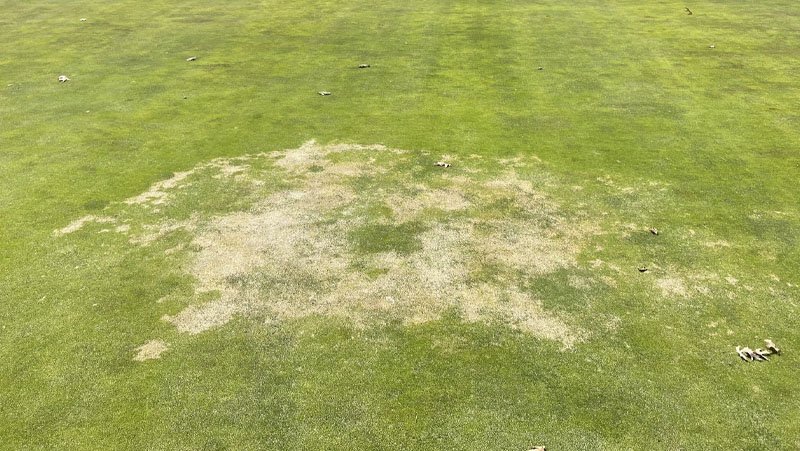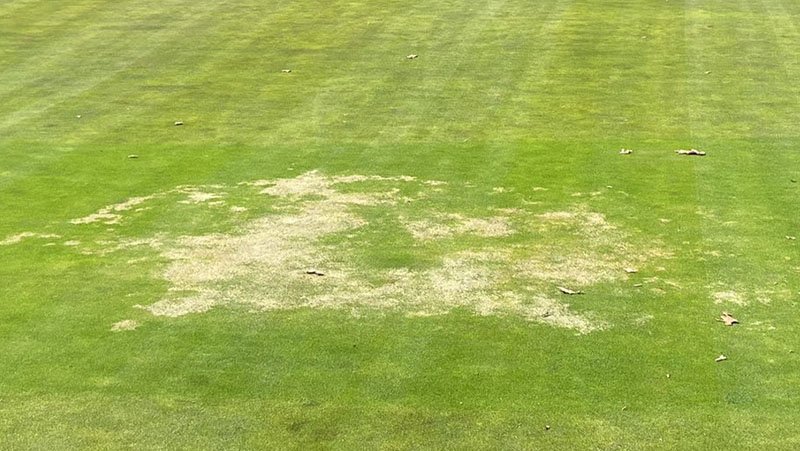
When it comes to dishing out punishment on golf courses, diseases play no favorites.
Winter damage caused by repeated cycles of thawing and refreezing of soaked putting greens historically is a sporadic issue on golf courses. When it shows up, it does not care whether the superintendent is a rookie on a public golf course or a seasoned veteran getting ready for a major championship.
The winter of 2022, specifically the month of February, provided one of those occasional periods of distress for many superintendents in the Northeast. Private and daily fee golf courses throughout the Northeast were equally affected.
As spring weather emerges and turf begins to green up, there is evidence that a series of freeze-thaw cycles in February have caused damage of varying degrees on Poa annua putting greens throughout parts of the Northeast.
"When it comes to winter damage," said Steve McDonald, a golf turf consultant and owner of Turfgrass Disease Solutions, "Mother Nature does not discriminate."
McDonald has conducted site visits to dozens of golf courses this year where winter damage has been an issue. The severity of damage has been indiscriminate.
"I've seen damage that is only the size of a pillow to about 60 percent of the putting surface. I've seen it on all the greens (on a golf course) and on just a few," McDonald said.
"I can visit five or six courses a day within 30 to 40 minutes of each, and it's all different."
When it comes to winter damage. Mother Nature does not discriminate.
Tony Girardi has spent 28 of his 33 years as a superintendent at Rockrimmon Country Club in Stamford, Connecticut, and winter damage has been an infrequent visitor there. This year is the first time he has seen it at Rockrimmon since 2015.
Of this year's damage, Girardi said: "We got clobbered."
"We had a freeze-thaw, then snow, then rain in January. That created slushy ice. That wasn't so bad," Girardi said. "Then we had temperature swings from the 20s to the 50s for the whole month of February."
Girardi is using permeable covers to accelerate growth so he can see every place where damage has occurred.
"We're still trying to assess damage," he said.
His multi-probed recovery plan includes resodding large areas, aerification and overseeding, or just letting the least-affected turf to grow out naturally.
"In 2015, there was distinct death in areas where water pooled. We were able to identify damage right away," he said. "This year, damage was widespread and not confined to one area."
At Fairview Country Club in Greenwich, Connecticut, Jim Pavonetti had minimal damage on three greens. He believes he was able to avoid further, more serious damage through an aggressive aerification program late last fall. That program started with an aerification procedure of three-fourths-inch holes on 2-inch spacing in November, followed by a drill-and-fill of 12-inch holes on 6-inch spacing, followed by another aerification procedure - also three-fourths inch on 2-inch spacing.

"With so many holes," Pavonetti said, "we did not have the surface water needed to create problems."
Currently, there is no science to back up the validity of any preventive measures, says turfgrass consultant John Daniels, agronomist with the USGA Green Section's Northeast Region. Any success, says McDonald, is purely anecdotal.
"The problem is this year we are seeing damage in areas where we are not accustomed to seeing damage. It's a head-scratcher," Daniels said.
"Damage is in varying degrees, even on the same golf course. That golf course might have damage, while others in the same town do not."
Chad Brown, superintendent at Norfolk Golf Club in Westwood, Massachusetts, can attest to that.
Brown has been on the job at Norfolk for less than two months, but knows the course inside-out. A former assistant at Norfolk, Brown left in 2019 to accept his first head superintendent position and returned when his former mentor, Jon Zolkowski, resigned earlier this year.
Even the installation of new drainage on the No. 7 green did not prevent damage from occurring there this year.
I considered plugging, but day by day it looked better, so I decided to let it ride. I did skip the first Proxy application in that area. I'll take any seedhead as long as we have turf.
"We still had ice damage," Brown said. "We had just radical changes in temperatures that did not allow surface water to penetrate."
He placed a permeable cover over the area to promote green-up and assess the extent of the damage.
"We covered that area from the last week of March and the first week of April," Brown said. "I considered plugging, but day by day it looked better, so I decided to let it ride. I did skip the first Proxy application in that area. I'll take any seedhead as long as we have turf."
In his days as an assistant under Zolkowski, Brown would dig out small pockets of problem areas, install pea gravel to promote drainage and re-cover the area with the turf canopy.
"After seeing damage this year, in the future, whatever I decide to do on greens in winter, I'm probably going to go old school and dig a hole again," Brown said. "I have to give the water somewhere to go."
Some years, winter damage might come in the form of desiccation on bare, exposed areas, or Poa greens encased in ice for extended periods. This year, a pattern of freeze-thaw cycles has resulted in crown hydration damage.
"A lot of damage can be traced back to drainage limitations on the surface or underground," Daniels said. "A lot of courses in the Northeast love their Poa greens, and they are proud of them. But winter damage is one of the risks you take when you try to maintain Poa greens in this part of the country. It's been six years since we've had damage, then boom! We have damage. It might be another six years before we see this again, or we might get hit again next year."
"There is not a hard-and-fast rule that says 'if this happens, all damage can be traced back to this.' There certainly are factors that predispose certain greens to more damage, but it's not as simple as you can just do one thing and then you're good, or fix one issue then you're good. It's much more complex and multifaceted as to what you can do.When we experience this kind of weather, really all we can do is keep our fingers crossed and hope the water can move before it refreezes."
Although there is no science to accurately predict when and where winter damage might occur, promoting overall soil health throughout the year could minimize the threat, Daniels said.
"We have to step back and ask, how strong and healthy are your greens year-round?" Daniels said. "If greens are in a weak state in October, I would expect them to be more vulnerable to winter damage in January, and in April if they have to recover. I don't think you can push greens so hard in the summer, then just raise the height of cut going into winter and think that is going to absolve you of all your problems going forward."


